The Hondajet is a unique aircraft in many respects. It's the first private jet to utilize overwing engine mounts. It's the first FAA-certified jet to be manufactured by a major automobile manufacturer. And it utilizes natural laminar flow technology on not only the wing, but also the nose section of the fuselage.
And it's unique in another respect. As far as I can tell, no other business jet model has gone fifteen years without any significant changes to the stock factory livery.
Thus far, despite having built over 85 examples, Honda has only changed the accent color. In the case of their largest customer, Wijet, has painted more of the vertical stabilizer as shown here:
But with those two very minor exceptions, the Hondajet paint scheme has remained essentially unchanged since its first flight back in 2003.
Why?
Does some kind of technical limitation exist? Must the forward fuselage be painted differently than the aft for some reason? Does Honda lack the technical ability to alter the overall pattern during the manufacturing process?
It's possible that Honda does, in fact, offer different paint designs to their customers. Which then begs the question, why do none opt for something different? Perhaps the change would result in added expense, but with a sticker price of around $6 million, one would think such a change would be a relatively minor addition.
While it would be nice to see more variety for variety's sake, it would also be interesting to see how various paint schemes would hide...or reveal...the bulbous cockpit section.
The addition of a dark mask surrounding and extending beyond the cockpit windows could add visual length, nicely streamlining the look and proportions of the fuselage. And contrasting or blending the colors of the engine nacelles and rear fuselage could visually highlight or hide them, respectively, according to the customer's preference.
If anyone has any first-hand info regarding the stagnation of the Hondajet color scheme, and can explain why it has remained essentially unchanged since the jet's debut in 2003, please share in the comments.











